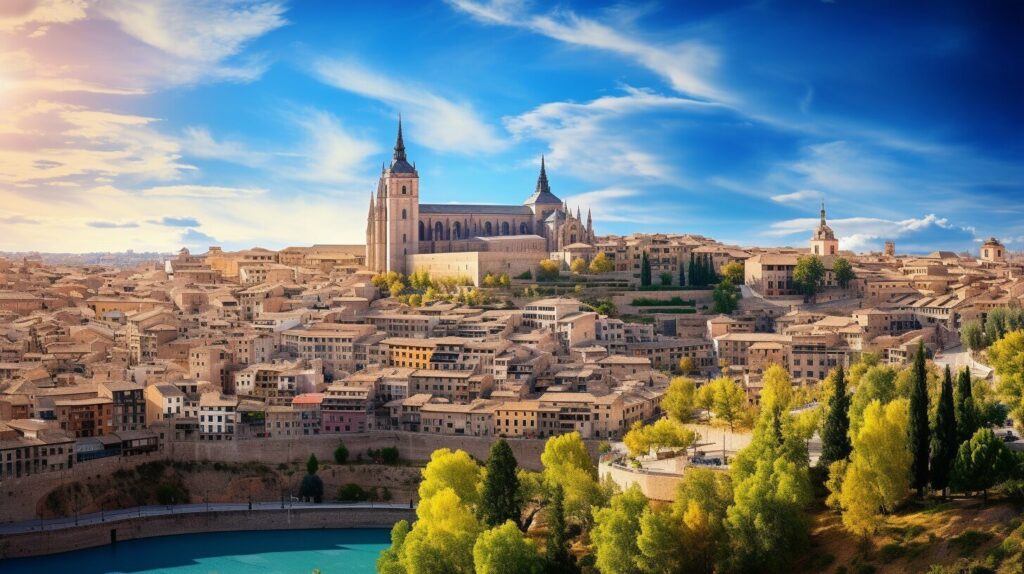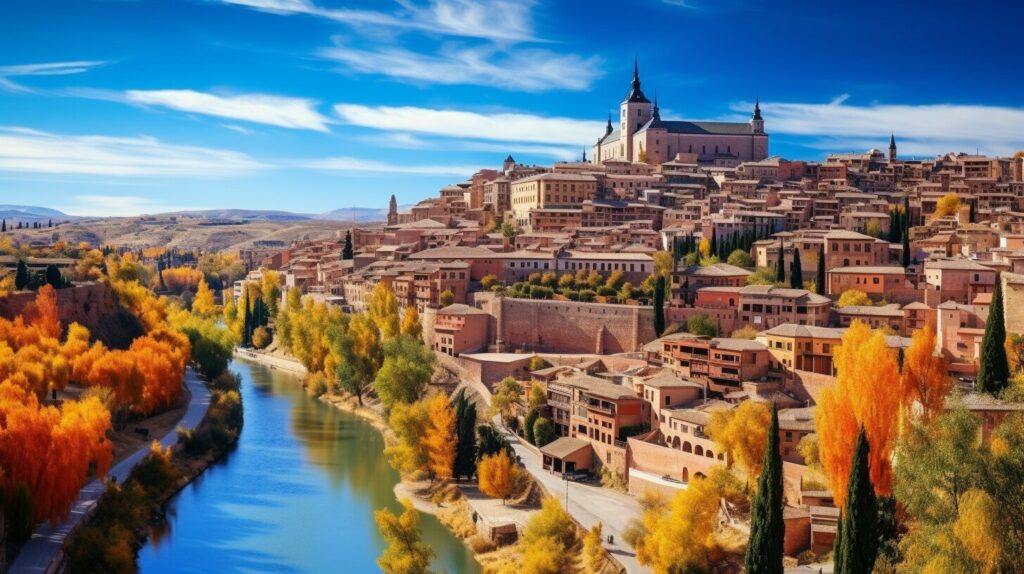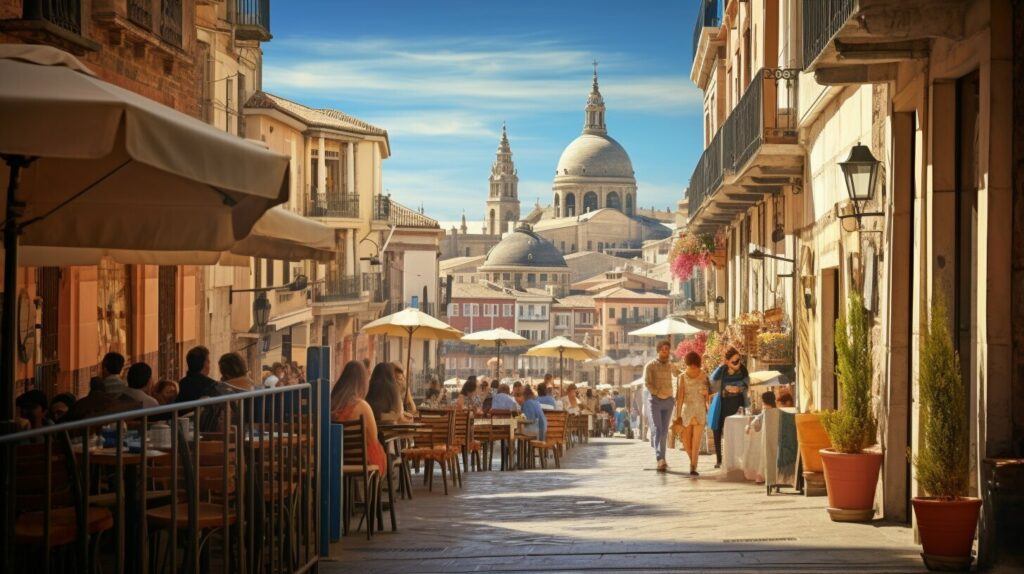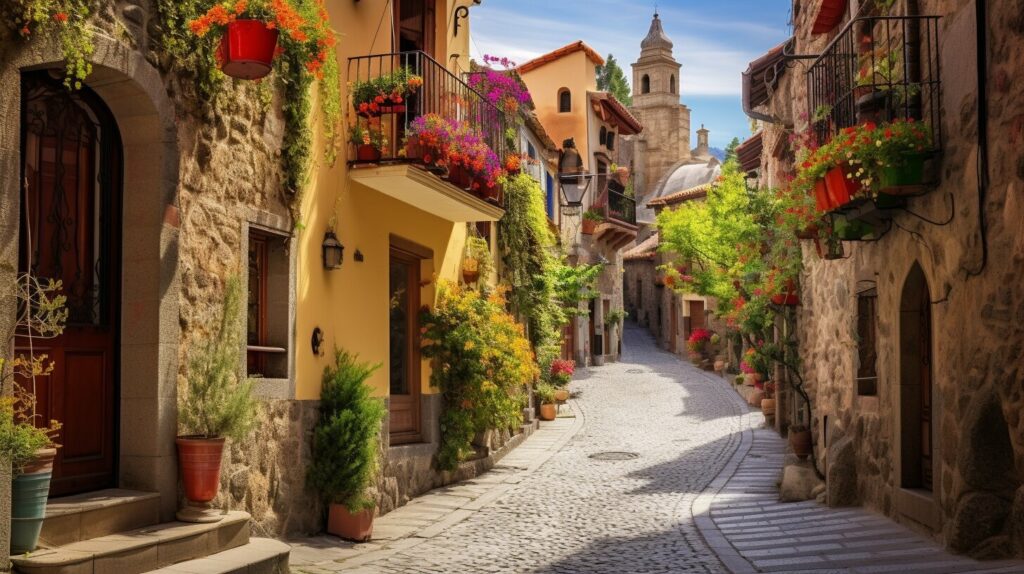Welcome to Toledo, a charming city filled with rich history, stunning architecture, and a vibrant atmosphere. Whether you are a first-time visitor or returning for another adventure, Toledo offers endless opportunities for exploration and discovery. In this article, we highlight the top places to visit in Toledo, including hidden gems, must-see attractions, and unique experiences. So, gear up and get ready to immerse yourself in the beauty and culture of Toledo!
Key Takeaways:
- Toledo is a charming Spanish city filled with rich history and stunning architecture.
- The city offers endless opportunities for exploration and discovery.
- This article highlights the top places to visit in Toledo, including hidden gems, must-see attractions, and unique experiences.
Toledo Cathedral: A Gothic Marvel
As one of the most prominent Gothic architectural masterpieces in Toledo, the Toledo Cathedral is a must-visit for any visitor to the city. This grand cathedral, also known as the ‘Primate Cathedral of Saint Mary of Toledo,’ dates back to the 13th century and is a symbol of the city’s religious and cultural heritage.
The cathedral’s stunning architecture features a blend of styles, including Gothic, Baroque, and Renaissance elements. It boasts an impressive nave, designed by one of the greatest Spanish architects, Enrique Egas. Visitors can marvel at the intricate details of the cathedral’s façade and the towering bell tower, which offers breathtaking views of the city.
Not only is the Toledo Cathedral architecturally significant, but it also houses numerous works of art, including paintings, sculptures, and tapestries. Visitors can see the famous ‘Transparente,’ a Baroque altarpiece that features an intricate carving of the Eucharist. The choir stalls are also a noteworthy feature, with intricate carvings and beautiful artwork.
One cannot miss the impressive sacristy, which houses numerous valuable liturgical objects, including the ‘Tabula Bella,’ a 12th-century silver altar front.
Fun Fact: The cathedral is home to one of Spain’s largest organs, featuring over 5,000 pipes!
Alcázar of Toledo: A Fortress with Rich History
Located in the heart of Toledo, the Alcázar is a fortress that has stood the test of time. The building, which dates back to the 16th century, was initially constructed as a palace for King Carlos V, but it has since served many purposes.
Today, the Alcázar houses the Army Museum of Spain, which provides an insight into the country’s military history. Visitors can explore the castle’s many rooms and galleries, including an armory and a chapel. The fortress’s architecture is an awe-inspiring sight, with its stone walls and turrets towering over the city.
But the Alcázar’s history goes beyond its architecture and art. It has played a significant role in Spanish history, serving as a military academy and a prison during the Spanish Civil War. Additionally, it was the site of the infamous Siege of the Alcázar, a battle that took place during the early days of the war.
Visitors to the Alcázar can take guided tours to learn more about the fortress’s history. They can also enjoy stunning views of the city from the castle’s terraces and balconies.
Santa María la Blanca: The Synagogue Turned Museum
Santa María la Blanca is a unique attraction in Toledo, Spain. Originally built as a synagogue in the 12th century, it was later converted into a Christian church before eventually becoming a museum. Its architectural style reflects the intricate combination of Jewish and Islamic cultures that once flourished in Toledo.
Inside this historical site, visitors can explore the museum exhibits that showcase the Jewish heritage of Toledo, including ritual objects, manuscripts, and photographs. The highlight of the museum is undoubtedly the stunning Mudejar ceiling, a beautiful example of Islamic artistry.
The synagogue’s layout is typical of the Mudejar style of Moorish-influenced architecture, with horseshoe-shaped arches and ornate carvings. The building’s history is a testament to the harmonious coexistence of different cultures in Toledo throughout history, and its conversion into a museum represents the importance of preserving cultural heritage.
If you’re interested in learning more about the Jewish history and cultural influence in Toledo, Santa María la Blanca is a must-visit attraction. Its unique blend of architecture, history, and exhibits make it a hidden gem in the city.
“Visiting Santa María la Blanca was a highlight of our trip to Toledo. The building’s Mudejar architecture and the exhibits on display truly capture the city’s rich cultural history.” – TripAdvisor Review
The Toledo City Walls: Discovering the Ancient Defenses
Walking along the winding paths of Toledo’s old city, the historic city walls loom in the distance. Stretching over two miles, these ancient fortifications have protected the city for centuries, and today they offer visitors a glimpse into Toledo’s rich history.
The walls are made of stone and brick, built during the 8th century, and feature towers, ramparts and gates. Visitors can access the walls via several entry points, and guided walking tours are available that reveal many hidden secrets about the walls and the city they protect.
| The most notable sections of the walls are: | Distance |
|---|---|
| Alcántara Bridge to Puerta del Sol | 1.4 km |
| San Cristóbal to San Martín | 1.1 km |
| Bisagra Gate to Sol Gate | 0.8 km |
Walking along the walls provides visitors with panoramic views of the city, including Toledo’s old town, river Tagus and surrounding hills. Don’t miss some of the most picturesque segments of the walls such as the “Paseo del Miradero” near Puerta de Alfonso VI gate and Puerta de Valmardon, both positioning alongside the panoramic views of the city.
The city walls’ history is intertwined with Toledo’s past. They have seen many conflicts, including battles for control of the city and the invasion of the Visigoths. The walls are also a testament to Toledo’s multicultural history, having been built by the Romans, and later, shaped by the Moors and Christians.
Visiting the Toledo City Walls is a unique way to experience the city’s rich history and is a must-see attraction for anyone visiting Toledo.
Santo Tomé Church: Home to El Greco’s Masterpiece
Santo Tomé Church is a must-visit attraction for art and history lovers in Toledo. This 14th-century church is primarily known for housing one of the most important works of the Spanish Renaissance painter El Greco, “The Burial of the Count of Orgaz.”
The church’s architecture, a mix of Gothic and Mudéjar styles, is also worth admiring. Its ornate doorway and bell tower are particularly noteworthy. The interior of the church is equally impressive, with vaulted ceilings and intricate decorations.
The highlight of any visit to Santo Tomé Church is, of course, “The Burial of the Count of Orgaz.” The painting depicts the burial of a nobleman and a local saint in Toledo. The work is famous for its use of light and shadow, as well as its emotional impact. Visitors may also appreciate the small museum within the church, which displays various religious artifacts and sculptures.
Monastery of San Juan de los Reyes: A Symbol of Triumph
The Monastery of San Juan de los Reyes is not just another religious site in Toledo. It’s a remarkable example of architectural beauty and a symbol of triumph. The monastery was built in the late 15th century to commemorate the victory of the Spanish monarchs over the Portuguese in the Battle of Toro.
The monastery is an impressive example of Gothic architecture and Renaissance decoration. Visitors can admire the elaborate facades, the ornate cloisters, and the intricate details of the church’s interior. The monastery also has a lovely garden, which offers a peaceful retreat from the hustle and bustle of the city.
Inside the church, visitors can see the beautiful altarpiece, which was created by the Flemish artist, Cornelis of Holland. The altarpiece is ornately decorated with gold leaf, paintings, and sculptures of saints.
The Monastery of San Juan de los Reyes was also once a Royal pantheon, and the tombs of King Ferdinand II of Aragon and Queen Isabella I of Castile can be found here. Visitors can pay their respects to these historical figures, who played a significant role in the unification of Spain.
Overall, the Monastery of San Juan de los Reyes is a must-visit destination for anyone traveling to Toledo. Its cultural and historical significance, combined with its architectural beauty, make it a unique and memorable experience.
Zocodover Square: The Heart of Toledo
Zocodover Square, located in the heart of Toledo, is a bustling hub that brings together tourists and locals alike. This central square is steeped in rich history and has been a popular gathering place for centuries.
Surrounded by historical buildings with intricate facades, Zocodover Square emanates a vibrant and lively atmosphere that is hard to resist. The square offers a variety of shops, cafes, and restaurants, making it the perfect place to relax and take in the local culture.
What’s more, Zocodover Square serves as the starting point for many walking tours of the city. This means you can explore some of Toledo’s hidden gems while taking in the charm of the city at your own pace.
If you’re looking to do some shopping, Zocodover Square won’t disappoint. With an array of stores selling everything from traditional handicrafts to modern clothing, there’s something for everyone.
And when hunger strikes, there’s no shortage of dining options to choose from. Whether you’re in the mood for traditional Spanish cuisine or international fare, you’re sure to find a restaurant that suits your taste buds.
Overall, Zocodover Square is a must-visit destination in Toledo. Immerse yourself in the local culture, take a guided walking tour of the city, shop until you drop, and indulge in some delicious food. With so much to see and do, you won’t be disappointed.
Museo del Greco: Unveiling the Artist’s Legacy
The Museo del Greco is a must-visit for art enthusiasts and those interested in the life and legacy of the renowned artist, El Greco. Located in the heart of Toledo, this museum houses an impressive collection of the artist’s works, showcasing the distinct style and techniques that made him a master of his craft.
The permanent exhibition at the Museo del Greco includes a range of paintings, sculptures, and other artifacts from different stages of El Greco’s life and career. Visitors can admire the powerful religious scenes, portraits, and landscapes that demonstrate his skillful use of color, light, and composition. The museum also features a section dedicated to the restoration and conservation of artwork, highlighting the efforts of experts to preserve El Greco’s legacy for future generations.
Aside from its permanent collection, the Museo del Greco frequently hosts temporary exhibitions and events that explore different aspects of the artist’s life and work. These exhibits offer a deeper insight into El Greco’s artistic evolution, technique, and influence, providing a more comprehensive experience for visitors.
Whether you’re a seasoned art connoisseur or simply interested in learning more about Toledo’s cultural history, a visit to the Museo del Greco is a must. With its in-depth exploration of El Greco’s life and work, this museum is a testament to the enduring legacy of one of the world’s greatest artists.
Conclusion
Toledo is a city that encapsulates the beauty and richness of Spanish history and culture. From the grandeur of Toledo Cathedral to the historical significance of the Alcázar, there are endless sights to see and experiences to be had. But beyond the main attractions lie hidden gems such as the Santa Maria la Blanca museum and the breathtaking Toledo city walls, which offer unique insights into the city’s past.
Take a stroll through the vibrant Zocodover Square, indulge in the delicious local cuisine, and visit the Museo del Greco to fully immerse yourself in the city’s rich cultural heritage. With something for everyone, Toledo is a must-visit destination ideal for solo travelers, couples, and families alike.
Don’t Miss Out
Whether you’re a history buff, art lover, or simply looking for a charming and lively place to visit, Toledo has something in store for you. So, pack your bags, grab your camera, and get ready to be mesmerized by the charm of this Spanish city.
FAQ
Q: What are the top places to visit in Toledo?
A: Toledo offers a plethora of attractions and hidden gems to explore. Some of the must-visit places include Toledo Cathedral, Alcázar of Toledo, Santa María la Blanca, Toledo City Walls, Santo Tomé Church, Monastery of San Juan de los Reyes, Zocodover Square, and Museo del Greco.
Q: What makes Toledo Cathedral special?
A: Toledo Cathedral is a magnificent example of Gothic architecture and is considered one of the most important religious sites in Toledo. It boasts a rich history, unique features like its stunning stained glass windows, and offers visitors a chance to admire its grandeur and learn about its significance.
Q: Why is the Alcázar of Toledo worth visiting?
A: The Alcázar of Toledo is a historic fortress that holds great importance in the city’s history. Its architectural beauty and connection to significant historical events make it a must-visit attraction in Toledo. Exploring the Alcázar allows visitors to immerse themselves in the city’s past and discover fascinating stories.
Q: What is the story behind Santa María la Blanca?
A: Santa María la Blanca is a former synagogue turned museum that showcases Toledo’s Jewish heritage. Its unique architectural style and exhibits provide a glimpse into the city’s multicultural past. Visitors can learn about the building’s transformation and explore the exhibits that highlight the importance of Jewish history in Toledo.
Q: Why should I explore the Toledo City Walls?
A: The Toledo City Walls offer a chance to delve into the city’s ancient defenses and admire its architectural heritage. Walking along the walls provides panoramic views and a unique perspective of Toledo. Guided tours are available to enhance the experience and bring the history of the walls to life.
Q: What makes Santo Tomé Church significant?
A: Santo Tomé Church is renowned for housing El Greco’s masterpiece “The Burial of the Count of Orgaz.” Its architectural style and artistic treasures make it a fascinating attraction for art enthusiasts. Visitors can admire the painting and explore the church’s unique features that contribute to its overall charm.
Q: Why visit the Monastery of San Juan de los Reyes?
A: The Monastery of San Juan de los Reyes is a symbol of triumph and a stunning architectural masterpiece. Its historical and religious significance, intricate details, and peaceful atmosphere create an immersive experience. Exploring this monastery allows visitors to appreciate Toledo’s cultural heritage and marvel at its beauty.
Q: What can I expect in Zocodover Square?
A: Zocodover Square is the vibrant heart of Toledo, offering a mix of historical significance and modern attractions. It is surrounded by a variety of shops, cafes, and restaurants, making it a popular spot for shopping and dining. The square also hosts events and markets, adding to its lively atmosphere.
Q: What will I find at the Museo del Greco?
A: The Museo del Greco is dedicated to showcasing the works and legacy of the renowned artist El Greco. Visitors can explore the museum’s collection of his artwork, learn about his impact on Toledo’s cultural history, and discover temporary exhibitions or events that celebrate the artist’s genius.




